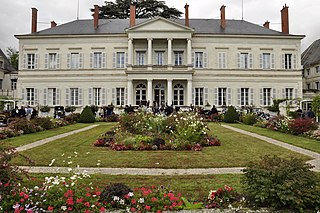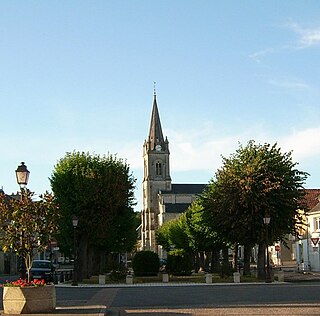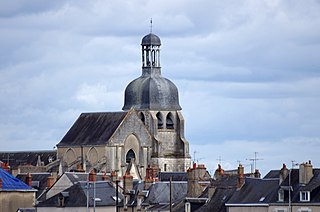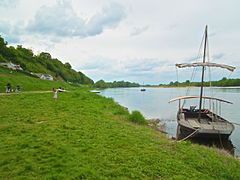
Orléans is a city in north-central France, about 120 kilometres southwest of Paris. It is the prefecture of the department of Loiret and of the region of Centre-Val de Loire.

Loir-et-Cher is a department in the Centre-Val de Loire region of France. Its name is originated from two rivers which cross it, the Loir in its northern part and the Cher in its southern part. Its prefecture is Blois. The INSEE and La Poste gave it the number 41. It had a population of 329,470 in 2019.

Blois is a commune and the capital city of Loir-et-Cher department, in Centre-Val de Loire, France, on the banks of the lower Loire river between Orléans and Tours.

The Vienne is a major river in south-western France. It is 363 km (226 mi) long. It is a significant left tributary of the lower Loire. It supports numerous hydroelectric dams, and it is the main river of the northern part of the Nouvelle-Aquitaine region.

Yzeures-sur-Creuse is a commune in the department of Indre-et-Loire, Centre-Val de Loire, France.

Descartes is a large village and commune in the Indre-et-Loire department in central France. It is approximately 29 kilometers east of Richelieu and about 48 kilometers east of Loudun, on the banks of the Creuse River, near the border of the French department of Vienne, and the border of the region between Centre-Val de Loire and Nouvelle-Aquitaine. It is famous for the birthplace of the French mathematician and philosopher who invented the Cartesian coordinate system, René Descartes.

Montsoreau is a commune of the Loire Valley in the Maine-et-Loire department in western France on the Loire, 160 km (99 mi) from the Atlantic coast and 250 km (160 mi) from Paris. The village is listed among The Most Beautiful Villages of France and is part of the Loire Valley UNESCO World Heritage Site.

The Authie is a river in northern France whose 108-kilometre (67 mi) course crosses the departement of the Pas-de-Calais and the Somme. Its source is near the village of Coigneux. It flows through the towns of Doullens, Auxi-le-Château, Nempont-Saint-Firmin and Nampont, finally flowing out into the Channel near Berck.
Ports-sur-Vienne is a commune in the Indre-et-Loire department in central France.

Navibus is a group of water bus routes in the French city of Nantes, operated as part of the Tan urban transit network that also includes buses and trams. Routes operate on both the River Loire and the River Erdre, and accept the full range of standard Tan tickets.

Vienne is a landlocked department in the French region of Nouvelle-Aquitaine. It takes its name from the river Vienne. It had a population of 438,435 in 2019.

Tours station is a railway station serving the city of Tours, Indre-et-Loire department, western France. It is situated on the Paris–Bordeaux railway, the Tours–Saint-Nazaire railway, and the non-electrified Tours–Le Mans railway. The Gare de Tours is a terminus; most TGV trains only serve the nearby Gare de Saint-Pierre-des-Corps.

The railway from Paris to Bordeaux is an important French 584-kilometre long railway line, that connects Paris to the southwestern port city Bordeaux via Orléans and Tours. The railway was opened in several stages between 1840 and 1853, when the section from Poitiers to Angoulême was finished. The opening of the LGV Atlantique high speed line from Paris to Tours in 1989 has decreased the importance of this section of the line for passenger traffic; the opening of the LGV Sud Europe Atlantique in 2017 has seen all long distance passenger trains migrating to that line and leaving space for more regional and local trains, as well as freight trains.

The Loire is the longest river in France and the 171st longest in the world. With a length of 1,006 kilometres (625 mi), it drains 117,054 km2 (45,195 sq mi), more than a fifth of France's land, while its average discharge is only half that of the Rhône.

Nouvelle-Aquitaine is the largest administrative region in France by area, spanning the west and southwest of Metropolitan France. The region was created in 2014 by the merging of Aquitaine, Limousin, and Poitou-Charentes in a territorial reform. Nouvelle-Aquitaine has an area of 84,035.7 km2 (32,446.4 sq mi) – more than 1⁄7 of Metropolitan France – and has a population of 6,033,952 as of 2020. The new region was established on 1 January 2016, following the regional elections in December 2015.

The canton of Sainte-Maure-de-Touraine is an administrative division of the Indre-et-Loire department, central France. Its borders were modified at the French canton reorganisation which came into effect in March 2015. Its seat is in Sainte-Maure-de-Touraine.

The Haute Perche Canal, despite its title, is a natural river, the Rivière de Haute-Perche, that has been slightly canalised to improve navigation between its mouth in the Bay of Bourgneuf at the port town of Pornic and the upstream settlements of Le Clion-sur-Mer, Chauvé and Arthon-en-Retz. It is located in the Pays de Retz in the Loire-Atlantique department and the Pays de la Loire region. It has also been known as the Canal de Pornic since the 16th century and was sometimes called the Étier de Haute Perche. Historically, it was called the Rouet, after the wheels of the water mills in the port.

Blois-Vienne, or merely Vienne for locals, is the common name given to the southern part of Blois, central France, separated from the rest of the city by the natural border of the Loire river. It corresponds to the subdistricts of St Saturnin, La Creusille, Les Métairies and La Vaquerie, but also include the hamlets of Bas-Rivière and Béjun, although these ones are now administratively attached to the neighboring commune of Chailles. In other words, it is now the left bank of the Loire in Blois.

Blois-Vienne Church is a Roman Catholic church located on the left bank of the Loire river in the city of Blois, France.





















